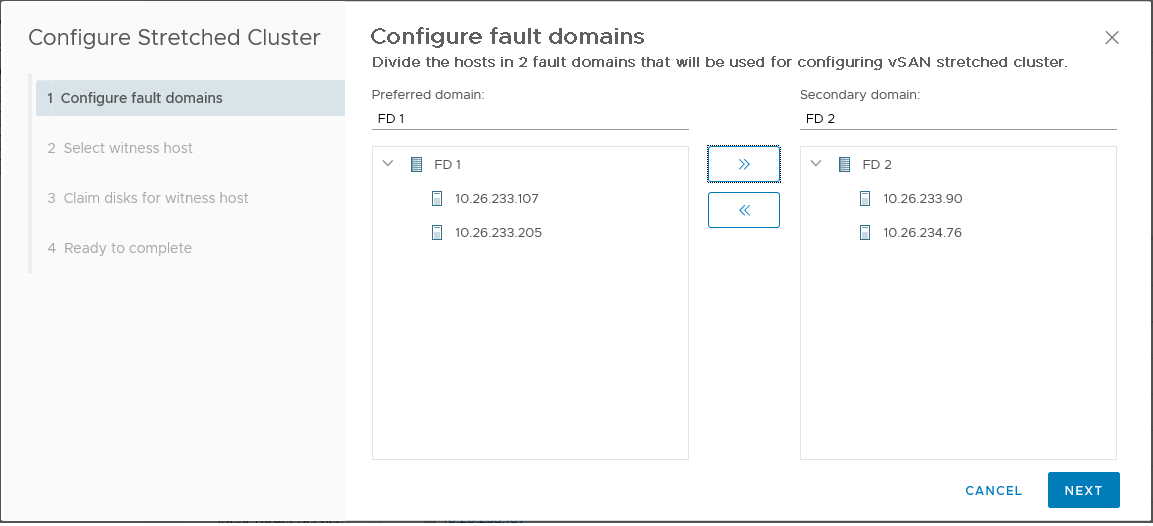Stretched clusters extend the vSAN cluster from a single data site to two sites for a higher level of availability and intersite load balancing. Stretched clusters are typically deployed in environments where the distance between data centers is limited, such as metropolitan or campus environments.
You can use stretched clusters to manage planned maintenance and avoid disaster scenarios, because maintenance or loss of one site does not affect the overall operation of the cluster. In a stretched cluster configuration, both data sites are active sites. If either site fails, vSAN uses the storage on the other site. vSphere HA restarts any VM that must be restarted on the remaining active site.
You must designate one site as the preferred site. The other site becomes a secondary or nonpreferred site. The system uses the preferred site only in cases where there is a loss of network connection between the two active sites. The site designated as preferred typically is the one that remains in operation, unless the preferred site is resyncing or has another issue. The site that leads to maximum data availability is the one that remains in operation.
A vSAN stretched cluster can tolerate one link failure at a time without data becoming unavailable. A link failure is a loss of network connection between the two sites or between one site and the witness host. During a site failure or loss of network connection, vSAN automatically switches to fully functional sites.

For more information about working with stretched clusters, see the vSAN Stretched Cluster Guide.
Witness Host
Each stretched cluster consists of two data sites and one witness host. The witness host resides at a third site and contains the witness components of virtual machine objects. It contains only metadata, and does not participate in storage operations.
The witness host serves as a tiebreaker when a decision must be made regarding availability of datastore components when the network connection between the two sites is lost. In this case, the witness host typically forms a vSAN cluster with the preferred site. But if the preferred site becomes isolated from the secondary site and the witness, the witness host forms a cluster using the secondary site. When the preferred site is online again, data is resynchronized to ensure that both sites have the latest copies of all data.
If the witness host fails, all corresponding objects become noncompliant but are fully accessible.
The witness host has the following characteristics:
- The witness host can use low bandwidth/high latency links.
- The witness host cannot run VMs.
- A single witness host can support only one vSAN stretched cluster.
- The witness host must have one VMkernel adapter with vSAN traffic enabled, with connections to all hosts in the cluster. The witness host uses one VMkernel adapter for management and one VMkernel adapter for vSAN data traffic. The witness host can have only one VMkernel adapter dedicated to vSAN.
- The witness host must be a standalone host dedicated to the stretched cluster. It cannot be added to any other cluster or moved in inventory through vCenter Server.
The witness host can be a physical host or an ESXi host running inside a VM. The VM witness host does not provide other types of functionality, such as storing or running VMs. Multiple witness hosts can run as VMs on a single physical server. For patching and basic networking and monitoring configuration, the VM witness host works in the same way as a typical ESXi host. You can manage it with vCenter Server, patch it and update it by using esxcli or vSphere Update Manager, and monitor it with standard tools that interact with ESXi hosts.
You can use a witness virtual appliance as the witness host in a stretched cluster. The witness virtual appliance is an ESXi host in a VM, packaged as an OVF or OVA. The appliance is available in different options, based on the size of the deployment.
Stretched Clusters and Fault Domains
Stretched clusters use fault domains to provide redundancy and failure protection across sites. Each site in a stretched cluster resides in a separate fault domain.
A stretched cluster requires three fault domains: the preferred site, the secondary site, and a witness host. Each fault domain represents a separate site. When the witness host fails or enters maintenance mode, vSAN considers it a site failure.
- Primary level of failures to tolerate (PFTT). For stretched clusters, PFTT defines the number of site failures that a virtual machine object can tolerate. For a stretched cluster, only a value of 0 or 1 is supported.
- Secondary level of failures to tolerate (SFTT). For stretched clusters, SFTT defines the number of additional host failures that the object can tolerate after the number of site failures defined by PFTT is reached. If PFTT = 1 and SFTT = 2, and one site is unavailable, then the cluster can tolerate two additional host failures.
The default value is 0, and the maximum value is 3.
- Data Locality. This rule is available only if PFTT = 0. You can set the Data Locality rule to None, Preferred, or Secondary. This rule enables you to restrict virtual machine objects to a selected site in the stretched cluster. The default value is None.
In a stretched cluster with local fault protection, even when one site is unavailable, the cluster can perform repairs on missing or broken components in the available site.